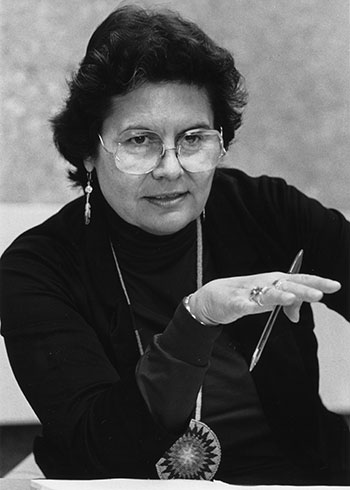
Portrait of Ada Deer sitting at a desk, Wisconsin Historical Society, Image 153534 (photograph, date, & creator):
Unknown.
I am grateful that the State Bar of Wisconsin has chosen to recognize the achievements of an individual who was not a lawyer in its first ever Indian law-focused issue of Wisconsin Lawyer. It is only fitting that Ada Deer receive such an honor. Ada was a brilliantly passionate Menominee woman who did not need a law degree to champion crucial social justice reforms and change Indian law and policy. From her humble beginnings in a log cabin, she successfully led the effort to restore Menominee tribal status, ran for state and federal office, earned a prestigious presidential appointment in the U.S. Division of Indian Affairs, and so much more. Her life was a constant striving to improve everything around her. Ada accomplished more firsts in her life than most of us could ever dream of.
This is how Ada described herself in Making a Difference: My Fight for Native Rights and Social Justice:
“I am a Menominee Indian. That is who I was born and how I have lived. I am tall like the trees that blanket my reservation in northern Wisconsin, and my skin is brown like their bark. Although I have not lived there in years, my roots grow deep in that rocky soil. That soil has anchored me during tumultuous times. I have roots elsewhere – geographically, ancestrally, and intellectually – and they too produced and nurtured the person I have become. But my taproot is Menominee.”1
Ada was born and raised alongside the beautiful Wolf River on the Menomonee Indian Reservation, in a home with no running water or electricity. The eldest of five children, she was an avid reader from an early age, completing her schoolwork by lamplight. Ada realized early on that education was her way out of impoverishment. When she became angry or depressed reading about the history of Native people, her mother would remind her, “You were put on this earth for a purpose. You are here to help people. You are here to help your people.”2 And did she ever!
While Ada was earning a bachelor’s degree in social work in the 1950s at the University of Wisconsin-Madison (the first Menominee and second Native to do so), Congress was engaging in actions that would have devastating effects on Indian tribes throughout the U.S. In 1953, Congress passed House Concurrent Resolution 108, which sought to terminate tribal status as quickly as possible, despite centuries of treaties and established case law recognizing the legal status of Indian tribes. “Termination” ended the long legal relationship between tribes and the federal government, stopped tribes from receiving federal aid and services, and dissolved Indian reservations. Numerous tribes across the country were terminated, and millions of acres of land were removed from trust status. Through the 1954 Menominee Termination Act, the Menominees became the only Indian tribe in Wisconsin to face this battle. [See “Menominee Termination and Restoration” elsewhere in this issue.]
 Martina Gast, U.W. 2011, is the founder of Pipestone Law LLC, Lake Mills. She provides employment law and human resources support to Indian tribes and tribal entities. She is a member of the Red Rock Indian Band. Gast was recently elected secretary of the State Bar of Wisconsin. She is a member of the State Bar’s BOG Governance Committee and Building Bridges Liaisons (Native American), the Indian Law Section board and a former chair, and the Solo Small Firm & General Practice Section.
Martina Gast, U.W. 2011, is the founder of Pipestone Law LLC, Lake Mills. She provides employment law and human resources support to Indian tribes and tribal entities. She is a member of the Red Rock Indian Band. Gast was recently elected secretary of the State Bar of Wisconsin. She is a member of the State Bar’s BOG Governance Committee and Building Bridges Liaisons (Native American), the Indian Law Section board and a former chair, and the Solo Small Firm & General Practice Section.
The devastating effects of termination became increasingly apparent while Ada was pursuing her master’s degree in social work at Columbia University (the first Native to do so) and in her work as a social worker in Minneapolis after graduation. As Ada described it:
“In less than a decade, we had seen our tribe dissolved and our future as a people destroyed. We had been self-supporting and self-governing. Our forest and mill provided employment, and tribal income funded education, health care, and social services. Now desperate poverty was widespread, forcing many young people to seek employment elsewhere. And the very land on which our former prosperity had rested was being sold out from under us.”3
Recognizing these existential threats to the Menominee people, Ada dedicated her prodigious energy to the fight to end termination, helping to found the Determination of Rights and Unity for Menominee Shareholders (DRUMS) organization, which was instrumental in ending termination and achieving restoration.
In 1971, at age 35, Ada was accepted to the University of Wisconsin Law School. In deciding to go to law school, Ada recognized that “to have a major impact on people’s lives, we needed to focus on the sources of their problems, which were often institutional and legal. We had to make the whole system more just if we were ever to obtain justice for individuals.”4 During the summer before starting law school, Ada and others worked ceaselessly, including testifying before the U.S. Senate Committee on Interior and Insular Affairs on the brutal effects of termination on the Menominees.
Ada’s law school experience turned out to be short-lived. She decided to devote herself completely to the fight for restoration, and she took a leave of absence. She explained, “I had hoped that I could use a law degree to help achieve restoration, but the Menominees needed help now, not in three years.”5 So when the need arose for someone to go to Washington, D.C. to lobby full time for the passage of a restoration bill, Ada volunteered and off she went. Ada and many other tribal members and allies lobbied tirelessly, educating anyone who would listen, even the reluctant.
After years of fierce commitment and advocacy, they ultimately succeeded in gaining the necessary support to reverse the course of law and policy. On Dec. 22, 1973, President Richard Nixon signed the Menominee Restoration Act into law (as Pub. L. No. 93-197), restoring the Tribe’s status. Ada then served as the chair of the Menominee Restoration Committee, which had the responsibility of leading the Tribe through the aftermath of restoration.
Ada was aunty, godmother, and mentor to generations of Native and non-
Native people. She understood the value of attorneys and wholeheartedly
encouraged students to attend law school.
In 1977, Ada began teaching at U.W.-Madison, splitting her time between the School of Social Work and the American Indian Studies Program, in which she was one of two faculty members. She took several leaves of absence from the university for pursuits in politics, including twice running for Wisconsin Secretary of State, and in 1992, running for Congress after winning the Democratic nomination.
In 1993, President Bill Clinton nominated her to serve as the Assistant Secretary of the Interior for Indian Affairs. After unanimous consent of the Senate, she became the first Native woman to ever hold that position. Upon returning to U.W.-Madison, she was appointed director of the American Indian Studies Program, from which she retired in 2007, having succeeded in greatly increasing the program’s scope and influence.
Although not an attorney, Ada had an immense effect on the Wisconsin legal community. Shortly after Ada’s passing in August 2023, State Bar Executive Director Larry Martin asked a large conference room full of legal professionals to raise their hands if they had the honor of either meeting Ada or hearing her speak at an event. Only a few hands remained down.
Ada was also an early supporter of Wisconsin Judicare and the Native American Rights Fund. Many of their attorneys were her friends, and she credited the organizations with taking on legal challenges at a time when few would. Beyond Indian law, Ada strongly believed in equal access to justice and ensuring that attorneys served the defenseless and members of oppressed communities, as our oath requires. One of the many causes she focused on in “retirement” was addressing the disproportionate incarceration of Indians in Wisconsin jails and prisons.
Ada was aunty, godmother, and mentor to generations of Native and non-Native people. She understood the value of attorneys and wholeheartedly encouraged students to attend law school. She is the reason that I am an attorney. Ada recognized that as a first-generation college student at U.W.-Madison, I could greatly benefit from her mentoring and quickly took me under her capable wing. During our many conversations, she always encouraged me to attend law school and become an Indian law attorney. Her most succinct advice was what her mother instilled in her: “You have a brain, use it.” Whether writing letters of recommendation, making invaluable introductions to her many friends, or encouraging breaks from studying to attend U.W.-Madison’s annual Varsity Band concert with her, her support was unwavering and everlasting. The impact she had on my life is far too great to even begin to explain in a short article like this. I know that many Wisconsin lawyers feel the same. Her roots really did spread wide.
Ada’s life is testimony to the fact that endless positive change, of a kind
that truly makes an exceptional difference in life and history forever, can
never be defined or limited by how few resources a person starts with.
I dearly miss her strong hugs and larger-than-life personality, her loud rhetorical insertions of “Whoa!” and “Hello?!” into her stories to underline her points, and her comments about the issues that “irked” her and her proposed solutions to them, and I miss being handed newspaper articles and necklace beads that she always seemed to have in the various bags she carried.
Ada constantly campaigned with her whole heart for causes she felt would improve the lives of people around her. She understood the importance of grassroots efforts and empowering people within their own communities. Even though she faced much opposition in her life, she never doubted that as long as we do good in the world, positive change would result. In Making a Difference, she implored:
“We as individuals cannot simply take up air and space. We need to work as individuals, communities, and tribes to create a better world. We have resources, and we need to protect them. We have talents, and we need to use them. We have histories, and we need to reflect on them. We have cultures, and we need to embrace them.”6
Ada’s life is testimony to the fact that endless positive change, of a kind that truly makes an exceptional difference in life and history forever, can never be defined or limited by how few resources a person starts with. The key lessons of her life and legacy are that we must all strive to be more kind, more willing, and more determined to improve the world around us. Thank you, Ada.
The world was a better place with Ada stomping around on it, storming forward, busting down doors. Those of us who were blessed to get to know Ada well know that she will never stop. I picture her walking on, reaching new destinations, and announcing her arrival with her loud booming voice “HELLO! I’M ADA DEER!”
Endnotes
1 Ada Deer, Making a Difference: My Fight for Native Rights and Social Justice 3 (University of Oklahoma Press: Norman, 2019).
2 Id. at 27.
3 Id. at 64-65.
4 Id. at 85.
5 Id. at 94.
6 Id. at 188.
» Cite this article: 97 Wis. Law. 44-46 (June 2024).
